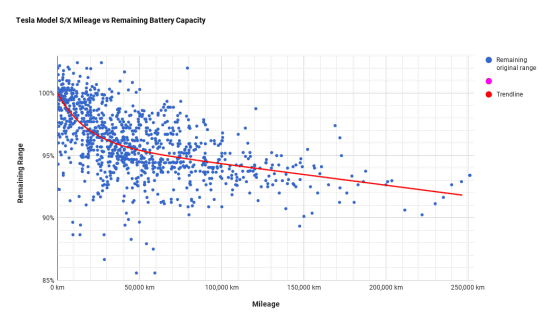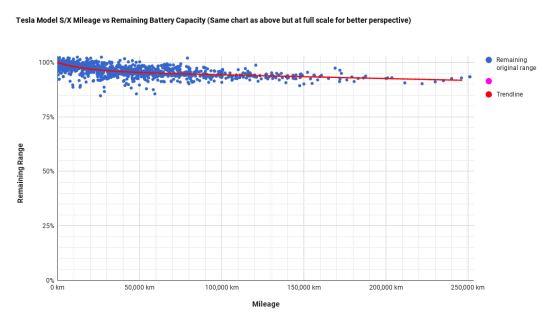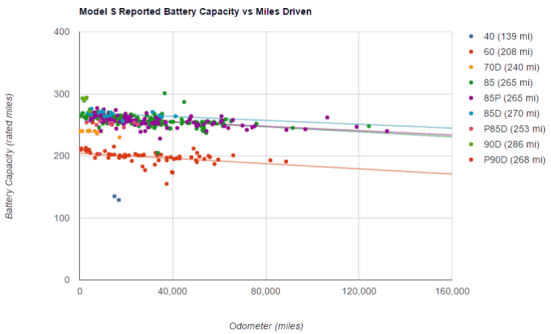What is the degree of deterioration of "battery" that can determine the life of Tesla Model S?

The battery which is an important part of the electric vehicle (EV) uses lithium ion battery is mainstream. However, since batteries such as lithium-ion batteries are inevitably degraded during use, they directly affect the cruising distance of the EV, so it is one of the important factors in considering the lifespan of EV. How much battery life of Tesla's model S has is graphed based on raw data of users of EU and North America.
Tesla Model S battery degradation data | Steinbuch
https://steinbuch.wordpress.com/2015/01/24/tesla-model-s-battery-degradation-data/
Tesla wears a product warranty for a model S battery for faults of 8 years with no distance limit. However, what is guaranteed is support for defective battery and it is not supported for deterioration of battery cell itself.
In addition to model S, most EVs use lithium ion batteries, which are familiar to smartphones and laptops. Since lithium ion batteries generally have "deterioration" that causes "battery holding" to deteriorate while using, for many EV owners, battery aging and aging deteriorates as products It can be said to be an important factor that greatly affects the life span.
The fan club "Tesla Motors Club" by Tesla car owners in the NetherlandsforumBased on the data on the remaining battery level listed in the graph, the vertical axis shows the deterioration degree of the battery, and the horizontal axis shows the mileage. The purpose of this graph is to accumulate data on model S batteries and predict battery life.
Red line is an approximate curve with reference to each point. The deterioration of the battery becomes gentle as the mileage increases. The point to note is that the vertical axis starts at 85%.

If you start from 0, you can easily see that it keeps more than 90% of the battery capacity even if you drive 250,000 kilometers. The deterioration of the battery against the mileage is much less pattern than expected.

The average value of the remaining capacity at the mileage of 240,000 kilometers was 92%. The approximate curve draws almost linear deterioration after 60,000 kilometers, and the proportion decreases by 1% every 50,000 kilometers. Assuming that this deterioration continues, it is 840,000 kilometers that is necessary to reduce the capacity of the battery to 80%, which would be a concern. General gasoline engine carsICE CarI think that it is possible to capture that the durability of Tesla's Model S battery is not a ratio of gasoline engine cars, given that the lifetime is 230,000 kilometers.
Model S has models with different battery capacities for different grades, but the pace of deterioration is moderate deterioration with respect to the mileage, and it seems that there will not be any situation where the battery deteriorates visibly.

In the graph below,TeslanomicsIt is a data of battery lifetime from Tesla car owner of EU, Canada, UK, USA created, and it is possible to change the mileage, the number of charge times, the use area etc from the menu on the right. From the graph, it does not depend almost on the place of use, and it can be confirmed that the remaining capacity is still more than 80% even if it exceeds 200,000 kilometers.
The world's first mass-produced EV's Nissan · Reef is talking about speed of deterioration of battery and insufficiency of battery security service.
I am concerned about battery life. Second-hand prices of electric cars are plummeting! (Mitsuhiro Kunizawa) - Individual - Yahoo! News
https://news.yahoo.co.jp/byline/kunisawamitsuhiro/20170707-00073002/
The mass production of the EV that moves with a completely different mechanism from the conventional type car driven by the engine is just beginning, and it seems that it will take time to judge whether the life expectancy will be as expected or not because it is necessary to accumulate future data .
Related Posts:







